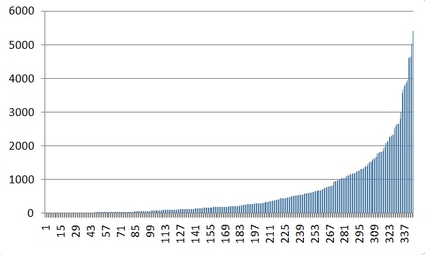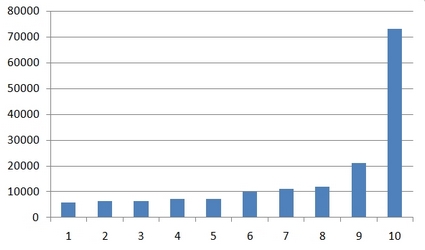

Sarah Palin did what?
The Importance of Redundancy
G. R. Boynton
It was but a drop in a roiling stream of 50 million messages a day. Three hundred and sixty seven times the word went out: "Sarah Palin Crossed Border For Canadian Health Care: http://bit.ly/cRRdAU". From time to time the basic messages was either adapted slightly or augmented with commentary by the tweeter, but the basic message was always the same. While living in Alaska Sarah Palin had regularly crossed into Canada for healthcare.
Why more than once? The same question could be asked about all communication utilizing Twitter. The Twitter stream is full of repetition. A power blackout in Chile after days of earthquakes is reported hundreds of times. Google threatening to pull out of China appears thousands of times. Redundancy reigns, but to what effect?
Twitter produces a loosely connected network, but the system does provide the tools for connection. One can follow -- automatically receive the messages of the other -- and be followed. This is a visible instantiation of opinion leadership. We have known since the 1940s that opinion leaders play a very important role in the flow of communication in society; it was initially called the two step flow of communication. But opinion leadership has been difficult to study because opinion leaders did not have the number of their followers emblazoned on their foreheads. With Twitter it is publicly available information on the person's home page. You can find the number of followers of anyone signed up on Twitter.
We know that a single signal in a loosely connected network either will not get around or it will take so long that it will be out of date before it makes it to most points. In a loosely connected network many signals, redundancy, is necessary to speed the signal through the network. If you count the followers of the 367 initiators of this message you find they transmitted the message to 366,636 followers. And that is a thousand to one multiplier effect. This is not the only way one might have come across the message. If you did a search for Palin on the right day, for example, you would have pulled up the message along with about 500 more. But 1,000 to 1 looks like very efficient message transmission.
Research on the use of Twitter has regularly found that most people who sign up are barely active, but that there is a small contingent -- something on the order of 10% -- who produce most of the 50 million messages a day. It is obvious from the 1,000 to 1 ratio that the 367 initiators of this message are not 'most people.'
The two figures plot the distribution of number of followers.
97% Opinion Leaders |
Top 10 Opinion Leaders |
 |
 |
The top ten in followers so dominate the rest that the two groups need to be presented separately. Most of the opinion leaders are in the 97% figure. The lowest is actually 0 followers, but that person did send the message. Roughly two-thirds have fewer than 1,000 followers, and one-third have more than 1,000 followers. Among the top 10 the smallest number of followers was 5,788 and the largest was 73,295. The median for the entire population was 207.
With this level of following one might want to be sure that the netword really is loosely connected. Perhaps the total number receiving the message is substantially less than 366,636. Twiangulate will identify the followers any two Twitter users have in common. Doing the entire 637 would require 67,161 comparisons, which is a bit much for a brief report. But if I do the top 10 and 10 at the median that should give a reasonable indication of the connectedness of the network. For the top 10 the average number of shared followers was 104. However, that was only 2.9% of all their followers. So 97.1% of their followers were uniquely receiving a message from the individual followed. The number of shared followers for the 10 at the median was 10 which was 4.4% of their total number of followers. This is a loosely connected network in which the redundancy produces a spread of 'the word.'
© G. R. Boynton, March 16, 2010